Perceived and Real Aquatic Competence in Children from 6 to 10 Years Old
Abstract
:1. Introduction
2. Materials and Methods
2.1. Participants
2.2. Assessment of the Perceived Aquatic Competence
2.3. Assessment of Real Aquatic Competence
2.4. Statistical Analysis
3. Results
4. Discussion
5. Conclusions
Author Contributions
Funding
Conflicts of Interest
Appendix A
Assessment of the Perceived Aquatic Competence (Structured Interview)
| (Sk1) Can you jump into the water? | ||||
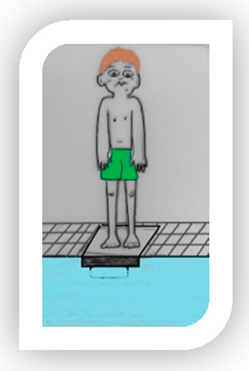 | 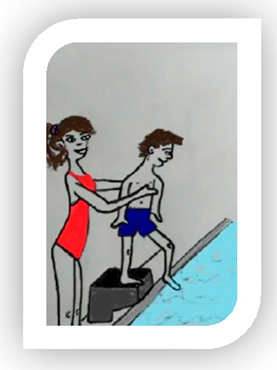 | 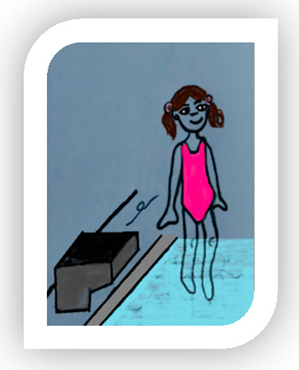 | 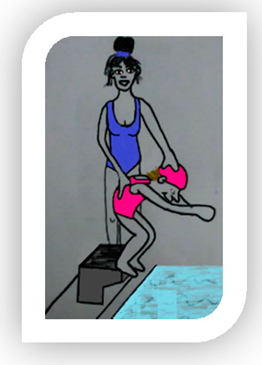 |  |
| A. “I cannot jump into the water” | B. “I can perform a foot entry, but I need the teacher assistance” | C. “I can perform a foot entry all by myself” | D. “I can perform a head diving, but I need the teacher assistance” | E. “I can perform a head diving all by myself” |
| (Sk2) In deep water, can you recover to surface in a lean down position (with your belly facing the bottom of the pool) to start swimming? | |||
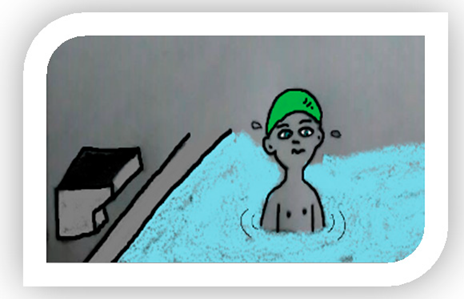 | 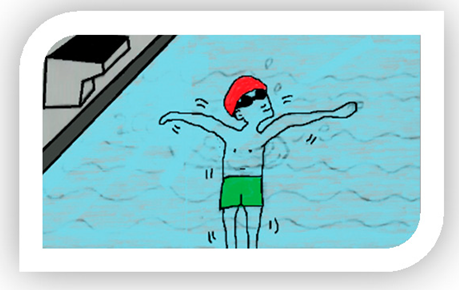 |  | 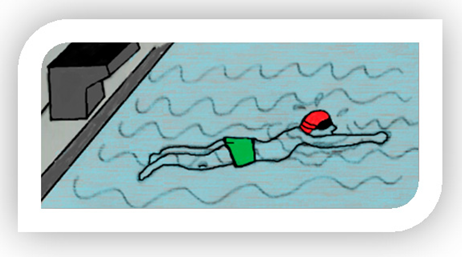 |
| A. “I cannot start swimming” | B. “I can start swimming but in an upright position” | C. “I can start swimming, but my feet are in a lower position” | D. “I can start swimming with my body completely at the water surface” |
| (Sk3) If you jump into the water, can you swim underwater and through the hoops? | ||||
 | 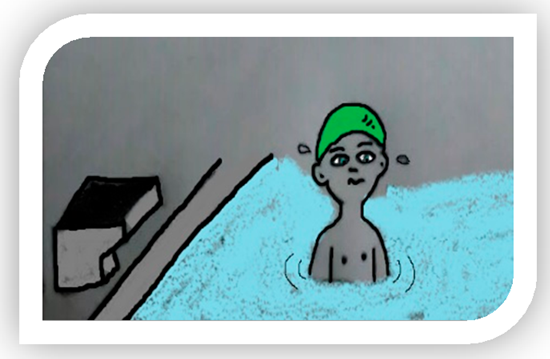 |  | ||
| A. “I cannot jump into the water” | B. “I can jump into the water, but I cannot swim underwater” | C. “I can jump into the water and perform a short underwater course (through one hoop)” | D. “I can jump into the water and perform a good underwater course (through two hoops)” | E. “I can jump into the water and perform a very long underwater course (through more than two hoops)” |
| (Sk4a) Can you swim front crawl? | ||||
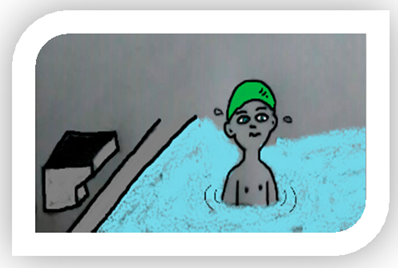 | 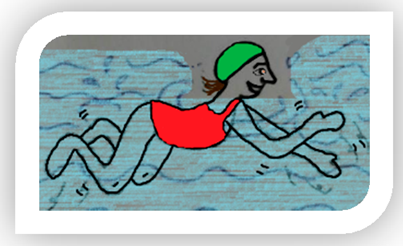 | 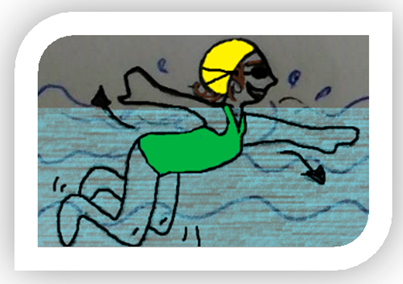 |  | 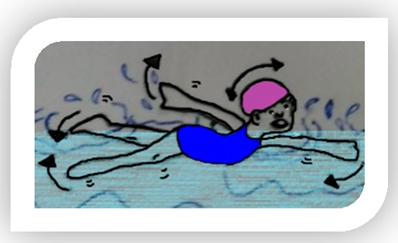 |
| A. “I cannot swim” | B. “I can only swim like a dog paddle” | C. “I can swim in a tilted position, moving my arms mostly through the water. I stop swimming, or I lift my head forward to breathe,” | D. “I can swim, moving my arms and legs alternately but I have no breathing control” | E. “I can swim front crawl well, without any difficulty in breathing” |
| (Sk4b) Can you swim backstroke? | ||||
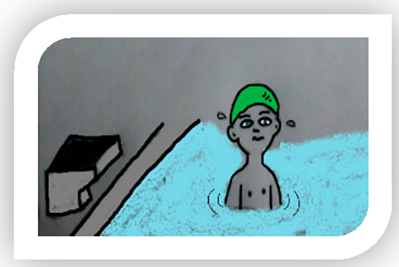 | 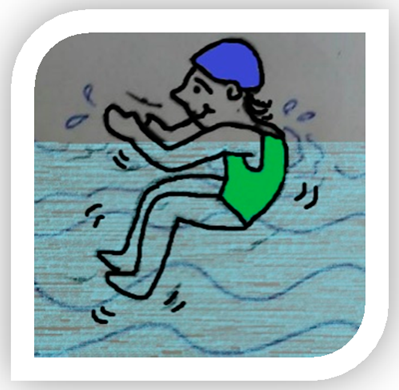 | 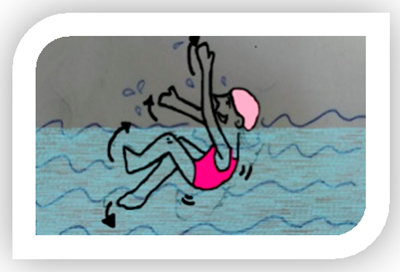 | 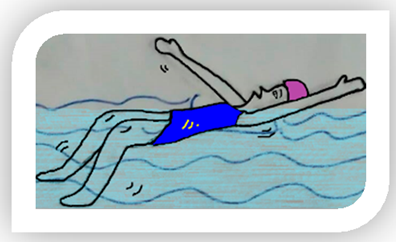 | 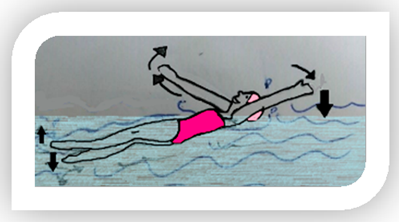 |
| A. “I cannot swim” | B. “I can swim in a shrunken position (almost sitting) and move practically only the arms” | C. “I can swim in a tilted position, moving my arms and legs through the water. | D. “I can swim backstroke, with alternating movements of arms but my feet are in a lower position” | E. “I can swim backstroke well, without any difficulty” |
| (Sk5) Do you master a proper breathing technique while swimming (front crawl)? | |||
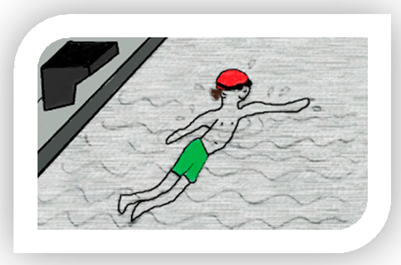 | 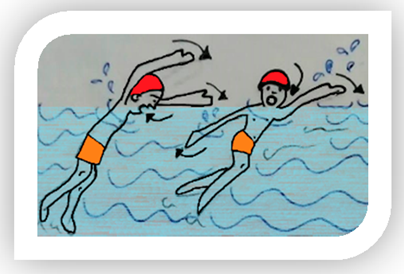 | 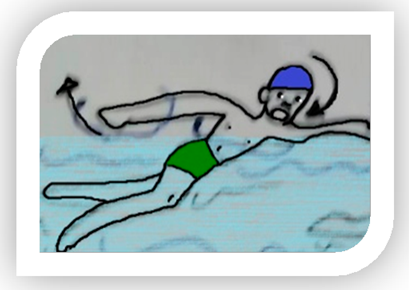 | 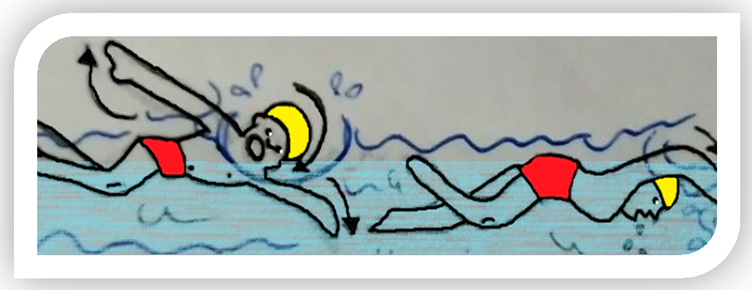 |
| A. “I cannot breathe during the swim” | B. “I try to breathe while swimming, but in order to do so I stop moving my arms and legs, and I usually sink” | C. “I can breathe while swimming, but when I lift my head to breathe, I lose a lot of speed and direction” | D. “I master a good breathing technique while swimming, without any difficulty” |
| (Sk6) Can you make a body rotation in the water without any support? | ||
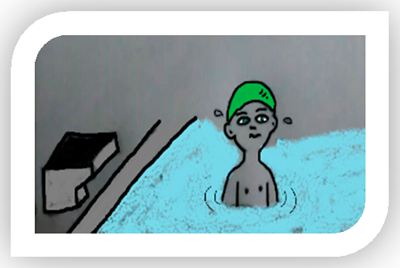 | 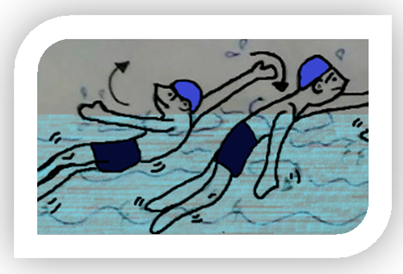 | 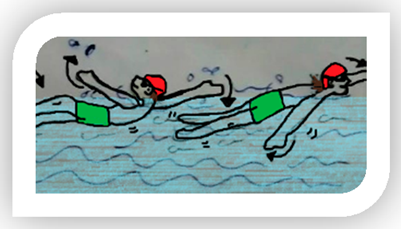 |
| A. “I cannot change my body position without any support” | B. “I can do a body rotation without any support, but I usually cannot finish the rotation in the same position that I have started, so the legs tend to sink” | C. “I can do a rotation of the body in the water without any support and finish it in the same position I have started (lying in the water)” |
| (Sk7a) Can you get around the balloons while you are swimming front crawl without stopping or putting your feet on the ground? | ||
 | ||
| A. “I cannot get around the balloons while I swim without putting my feet on the ground.” | B. “I can, but I have to stop swimming to get around the balloons and change direction” | C. “I can contour the balloons and change direction while swimming” |
| (Sk7b) Can you get around the balloons while you are swimming backstroke without stopping or putting your feet on the ground? | ||
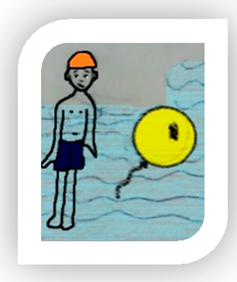 |  | |
| A. “I cannot get around the balloons while I swim backstroke without putting my feet on the ground.” | B. “I can, but I have to stop swimming to get around the balloons and change direction” | C. “I can contour the balloons and change direction while swimming backstroke” |
| (Sk8) Can you float for 30 s in a footless area without moving your arms and legs? | ||
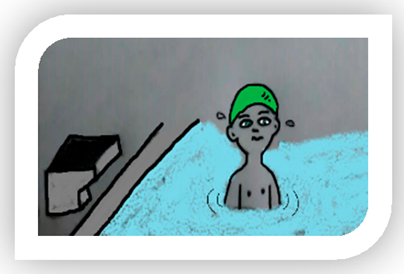 | 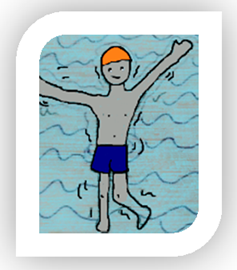 |  |
| “I cannot float for so long” | “I can, but I have to move my arms and legs to keep myself at the surface” | “I can float very well and almost without moving” |
References
- Childhood Injuries in the United States. Am. J. Dis. Child. 1990, 144, 627–646. [CrossRef]
- Christoffel, K.K.; Schofer, J.L.; Jovanis, P.P.; Brandt, B.; White, B.; Tanz, R. Childhood pedestrian injury: A pilot study concerning etiology. Accid. Anal. Prev. 1986, 18, 25–35. [Google Scholar] [CrossRef]
- Lee, D.N.; Young, D.S.; Mclaughlin, C.M. A roadside simulation of road crossing for children. Ergonomics 1984, 27, 1271–1281. [Google Scholar] [CrossRef]
- Plumert, J.M. Relations between children’s overestimation of their physical abilities and accident proneness. Dev. Psychol. 1995, 31, 866–876. [Google Scholar] [CrossRef]
- Nixon, J.; Pearn, J.; Wilkey, I.; Corcoran, A. Fifteen years of child drowning— A 1967–1981 analysis of all fatal cases from the Brisbane drowning study and an 11 year study of consecutive near-drowning cases. Accid. Anal. Prev. 1986, 18, 199–203. [Google Scholar] [CrossRef]
- Rejman, M.; Kwaśna, A.; Chrobot, M.; Kjendlie, P.-L.; Stalmann, R.K. Perceived Versus Real Swimming Skills of Adolescents under Standard and Challenging Conditions: Exploring Water Competencies as an Approach to Drowning Prevention. Int. J. Environ. Res. Public Health 2020, 17, 3826. [Google Scholar] [CrossRef]
- Global Report on Drowning: Preventing a Leading Killer; World Health Organization (Ed.) World Health Organization: Geneva, Switzerland, 2014; ISBN 978-92-4-156478-6. [Google Scholar]
- Garrido, N.D.; Costa, A.M.; Stallman, R.K. Drowning: A leading killer! Motricidade 2016, 12, 2–7. [Google Scholar] [CrossRef]
- Stallman, R.K.; Junge, M.; Blixt, T. The Teaching of Swimming Based on a Model Derived from the Causes of Drowning. Int. J. Aquat. Res. Educ. 2008, 2, 372–382. [Google Scholar] [CrossRef] [Green Version]
- Ruiz-Pérez, L.M. Competencia Motriz aquática: Uma questão de idades. Rev. Investig. En Act. Acuát. 2017, 1, 16. [Google Scholar] [CrossRef] [Green Version]
- Langendorfer, S.J. Changing Learn-to-Swim and Drowning Prevention Using Aquatic Readiness and Water Competence. Int. J. Aquat. Res. Educ. 2015, 9, 4–11. [Google Scholar] [CrossRef] [Green Version]
- Light, R.; Wallian, N. A Constructivist-Informed Approach to Teaching Swimming. Quest 2008, 60, 387–404. [Google Scholar] [CrossRef]
- Langendorfer, S.J. Considering Drowning, Drowning Prevention, and Learning to Swim. Int. J. Aquat. Res. Educ. 2011, 5, 236–243. [Google Scholar] [CrossRef] [Green Version]
- Avramidis, S.; Stallman, R. Proceedings of the Lifesaving Foundation’s 2010 Research Conference & Ireland Medal Ceremony; Avramidis, S., Stallman, R., Eds.; The Lifesaving Foundation: Dublin, Ireland, 2010. [Google Scholar]
- Baker, S.P.; O’Neill, B.; Ginsburg, M.J.; Li, G. The Injury Fact Book, 2nd ed.; Oxford University Press: New York, NY, USA, 1991; ISBN 978-0-19-974870-9. [Google Scholar]
- Langerdorfer, S.; Bruya, L. Aquatic Readiness: Developing Water Competence in Young Children; Human Kinetics: Champaign, IL, USA, 1995. [Google Scholar]
- Moran, K.; Stallman, R.; Kjendlie, P.-L.; Dahl, D.; Blitvich, J.; Petrass, L.; McElroy, G.; Goya, T.; Teramoto, K.; Matsui, A.; et al. Can You swim? An Exploration of Measuring Real and Perceived Water Competency. Int. J. Aquat. Res. Educ. 2012, 6, 122–135. [Google Scholar] [CrossRef] [Green Version]
- Quan, L.; Ramos, W.; Harvey, C.; Kublick, L.; Langendorfer, S.; Lees, T.; Fielding, R.; Dalke, S.; Barry, C.; Shook, S.; et al. Toward Defining Water Competency: An American Red Cross Definition. Int. J. Aquat. Res. Educ. 2015, 9, 12–23. [Google Scholar] [CrossRef] [Green Version]
- Ruiz Pérez, L.M.; Graupera Sanz, J.L. New measure o f perceived motorcompetence for children ages 4 to 6 years. Percept. Mot. Skills 2005, 101, 131–148. [Google Scholar] [CrossRef]
- Mirabile, R.J. Everything You Wanted to Know about Competency Modeling. Train. Dev. 1997, 51, 73–77. [Google Scholar]
- Zarifian, P. Objectif Compétence: Pour une Nouvelle Logique; Editions Liaisons: Paris, France, 1999. [Google Scholar]
- Moreno-Murcia, J.A.; Ruiz Pérez, L.M. Aquatic perceived competence in children: Development and preliminary validation of a pictorial sclae. Int. J. Aquat. Res. Educ. 2008, 2, 313–329. [Google Scholar]
- Harter, S. The Perceived Competence Scale for Children. Child Dev. 1982, 53, 87–97. [Google Scholar] [CrossRef]
- Shapiro, D.; Yun, J.; Ulrich, D.A. Measuring perceived gross motor skill competence in children. Int. J. Sport Psychol. 2002, 33, 391–409. [Google Scholar]
- Losier, G.F.; Vallerand, R.J. The temporal relationship between perceived competence and self-determined motivation. J. Soc. Psychol. 1994, 134, 793–801. [Google Scholar] [CrossRef]
- Karmiloff-Smith, A. Beyond Modularity: A Developmental Perspective on Cognitive Science; MIT Press: Cambridge, MA, USA, 1995; ISBN 978-0-262-61114-5. [Google Scholar]
- Coppens, N.M. Cognitive characteristics as predictors of children’s understanding of safety and prevention. J. Pediatr. Psychol. 1986, 11, 189–202. [Google Scholar] [CrossRef] [PubMed]
- Moran, K.; Gilmore, A. Children’s Understanding of Water Safety and Perceptions of Risk at the Beach. N. Z. J. Educ. Stud. 2018, 53, 227–239. [Google Scholar] [CrossRef]
- Kjendlie, P.-L.; Pedersen, T.; Thoresen, T.; Setlo, T.; Moran, K.; Stallman, R.K. Exploring beliefs about swimming among children and caregivers: A qualitative analysis. In Proceedings of the Proceedings of XII Biomechanics and Medicine in Swimming; Australian Institute of Sport: Camberra, Australia, 2014; p. 8. [Google Scholar]
- Moran, K.; Stanley, T. Parental perceptions of toddler water safety, swimming ability and swimming lessons. Int. J. Inj. Contr. Saf. Promot. 2006, 13, 139–143. [Google Scholar] [CrossRef] [PubMed]
- Stanley, T.; Moran, K. Self-Estimates of Swimming and Rescue Competence, and the Perceptions of the Risk of Drowning among Minority Groups in New Zealand—Life Saving or Life Threatening? J. Educ. Hum. Dev. 2018, 7, 10. [Google Scholar]
- Moran, K. Can You Swim in Clothes? An Exploratory Investigation of the Effect of Clothing on Water Competency. Int. J. Aquat. Res. Educ. 2014, 8, 338–350. [Google Scholar] [CrossRef] [Green Version]
- Moran, K. Can You swim in Clothes? Reflections on the Perception and Reality of the Effect of Clothing on Water Competency. Int. J. Aquat. Res. Educ. 2015, 9. [Google Scholar] [CrossRef] [Green Version]
- Moran, K. Can You Float? Part I—Perceptions and Practice of Unsupported Flotation Competency among Young Adults. Int. J. Aquat. Res. Educ. 2019, 10. [Google Scholar] [CrossRef]
- Moran, K. Can You Float? Part 2—Perceptions and Practice of Lifejacket Use Among Young Adults. Int. J. Aquat. Res. Educ. 2019, 11. [Google Scholar] [CrossRef] [Green Version]
- Moran, K. Dressed to kill? The effect of clothing on water competency. In Proceedings of the World Conference on Drowning Prevention, Penang, Malaysia, 4–6 November 2015; p. 84. [Google Scholar]
- Moran, K. I can swim but can I get out? The “exit problem” explored. In Proceedings of the World Conference on Drowning Prevention, Penang, Malaysia, 4–6 November 2015; p. 86. [Google Scholar]
- Junge, M.; Blixt, T.; Stallman, R. Progression in teaching beginning swimming: Rank order by degree of difficulty. In Proceedings of the XI International Symposium for Biomechanics and Medicine in Swimming, Oslo, Norway, 16–19 June 2010; Kjendlie, P.L., Stallman, R., Cabri, J., Eds.; Norwegian School of Sport Science: Oslo, Norway, 2010; pp. 329–330. [Google Scholar]
- Costa, A.; Marinho, D.; Rocha, H.; Silva, A.; Barbosa, T.; Ferreira, S.; Martins, M. Deep and Shallow Water Effects on Developing Preschoolers’ Aquatic Skills. J. Hum. Kinet. 2012, 32. [Google Scholar] [CrossRef]
- Rocha, H.A.; Marinho, D.A.; Garrido, N.D.; Morgado, L.S.; Costa, A.M. The acquisition of aquatic skills in preschool children: Deep versus shallow water swimming lessons. Motricidade 2018, 14, 66–72. [Google Scholar] [CrossRef]
- Zaichkowsky, L.B.; Zaichkowsky, L.D.; Martinek, T. Self-concept and attitudinal differences in elementary age school children after participation in a physical activity program. Mouvement 1975, 7, 243–245. [Google Scholar]
- Dunn, J.L.C.; Watkinson, E.J. A Study of the Relationship between Physical Awkwardness and Children’s Perceptions of Physical Competence. Adapt. Phys. Act. Q. 1994, 11, 275–283. [Google Scholar] [CrossRef]
- Roberts, M.C. Health promotion and problem prevention in pediatric psychology: An overview. J. Pediatr. Psychol. 1986, 11, 147–161. [Google Scholar] [CrossRef] [PubMed]
- Yang, L.; Nong, Q.-Q.; Li, C.-L.; Feng, Q.-M.; Lo, S.K. Risk factors for childhood drowning in rural regions of a developing country: A case-control study. Inj. Prev. J. Int. Soc. Child Adolesc. Inj. Prev. 2007, 13, 178–182. [Google Scholar] [CrossRef] [Green Version]
- Barbosa, T.M.; Fernandes, R.; Keskinen, K.L.; Colaço, P.; Cardoso, C.; Silva, J.; Vilas-Boas, J.P. Evaluation of the energy expenditure in competitive swimming strokes. Int. J. Sports Med. 2006, 27, 894–899. [Google Scholar] [CrossRef] [Green Version]
- Stallman, R.K.; Moran, K.; Quan, L.; Langendorfer, S. From Swimming Skill to Water Competence: Towards a More Inclusive Drowning Prevention Future. Int. J. Aquat. Res. Educ. 2017, 10, 3. [Google Scholar] [CrossRef] [Green Version]
- Choi, S.W.; Kurokawa, T.; Ebisu, Y.; Kikkawa, K.; Shiokawa, M.; Yamasaki, M. Effect of wearing clothes on oxygen uptake and ratings of perceived exertion while swimming. J. Physiol. Anthropol. Appl. Hum. Sci. 2000, 19, 167–173. [Google Scholar] [CrossRef] [Green Version]
- Bierens, J.J.L.M. (Ed.) Handbook on Drowning: Prevention, Rescue, Treatment; Springer: Berlin, Germany, 2006; ISBN 978-3-540-29656-0. [Google Scholar]
- Association for Child Safety Promotion. Afogamentos em Crianças e Jovens em Portugal Atualização de Casos—Junho de 2015; Association for Child Safety Promotion: Lisbon, Portugal, 2015. [Google Scholar]
- van Beek, E.F.; Branche, C.M.; Szpilman, D.; Modell, J.H.; Bierens, J.J.L.M. A new definition of drowning: Toward documentation and prevention of a global health problem. Bull. World Health Organ. 2005, 83, 853–856. [Google Scholar]
- Asher, K.N.; Rivara, F.P.; Felix, D.; Vance, L.; Dunne, R. Water safety training as a potential means of reducing risk of young children’s drowning. Inj. Prev. J. Int. Soc. Child Adolesc. Inj. Prev. 1995, 1, 228–233. [Google Scholar] [CrossRef] [Green Version]
- Oliveira, L.; Aranha, A.; Resende, R.; Cardoso, E.; Pimenta, N.; Garrido, N. Can We Test Swimming Lessons Skills in Drowning Prevention? Br. J. Sports Med. 2013, 47, e3. [Google Scholar] [CrossRef]
- Golden, F.; Tipton, M. Essentials of Sea Survival; Human Kinetics: Leeds, UK, 2002. [Google Scholar]
- Newell, K.M. Constraints on the development of coordination. In Motor Development in Children: Aspects of Coordination and Control; Wade, M.G., Whiting, H.T.A., Eds.; Martinus Nijhoff: Amsterdam, The Netherlands, 1986; pp. 341–360. [Google Scholar]
- Costa, A.; Garrido, N.; Rocha, H.; Marinho, D.; Silva, A.J. Water competency-based education: A key to promote motor development and optimal drowning prevention. In The Science of Swimming and Aquatic Activities; Fernandes, R., Ed.; Nova Science: New York, NY, USA, 2018; pp. 1–22. [Google Scholar]
| Skill | Scoring Scale | K | |
|---|---|---|---|
| Simple Condition | Complex Condition | ||
| (Sk1) Entry (jump or diving) in deep water | 0. Unable to enter the water voluntarily 1. Performs a foot entry with assistance 2. Performs a foot entry without being assisted 3. Performs a head diving with assistance 4. Performs a head diving without assistance | 1.0 | 0.932 |
| (Sk2) After immersion, recover to the water surface, get alignment and swim | 0. Unable to regain horizontality or start swimming 1. Unable to regain horizontality but starts swimming 2. Partially recovers horizontality and starts swimming 3. Regain horizontality and start swimming | 0.919 | 0.955 |
| (Sk3) Dive from the swimming pool edge and swim underwater | 0. Unable to jump into the water 1. Performs a jump into the water but is not able to perform an underwater course. 2. Performs a jump into the water followed by a short underwater course (<2 m) 3. Performs a jump into the water followed by a medium underwater course (<3 m) 4. Performs a jump into the water followed by a long underwater course (>3 m) | 0.726 | 0.749 |
| (Sk4a) Know at least in a rudimentary set the front crawl | 0. Does not reveal any propulsive motor behavior in the ventral position 1. Performs rudimentary swimming (globally known as “locomotive swimming”) 2. The beginning of the formal stroke is identified 3. Performs a rudimentary swimming technique (breathing, body position, kick, and arm strokes) 4. Performs an advanced swimming technique | 0.870 | 0.950 |
| (Sk4b) Know at least in a rudimentary set the backstroke | 0. There is no propulsive motor behavior in the dorsal position 1. Performs an undefined propulsive movement in the upright or seated dorsal position 2. The beginning of the formal stroke is identified 3. Performs a rudimentary swimming technique (breathing, body position, kick, and arm strokes) 4. Performs an advanced swimming technique | 0.957 | 0.956 |
| (Sk5) Controlled and relaxed breathing | 0. Performs a respiratory blockage during swimming 1. Performs respiratory cycles but without synchronization with the action of arms and legs 2. Performs respiratory rhythms synchronized with swimming but with loss of body alignment 3. Performs rhythmic breathing cycles, synchronized with swimming and with correct body alignment | 0.944 | 0.934 |
| (Sk6) Change body position (from dorsal to ventral and vice-versa) | 0. Unable to perform rotation 1. Performs the rotation in the longitudinal axis, but with loss of body horizontality 2. Performs the rotation in the longitudinal axis without loss of the body horizontality | 0.961 | 0.962 |
| (Sk7a) Change swimming direction (turn left or right at front crawl) | 0. Unable to change direction during swimming 1. Performs swimming direction but with successive stops 2. Performs swimming direction changes without interruption | 0.781 | 0.847 |
| (Sk7b) Change swimming direction (turn left or right at backstroke) | 0. Unable to change direction during swimming 1. Performs swimming direction but with successive stops 2. Performs swimming direction changes without interruption | 0.772 | 0.891 |
| (Sk8) Floating (stop and rest with minimum or without motion) | 0. Unable to maintain static vertical balance 1. Maintain static vertical balance, but with pronounced propulsive movements 2. Maintain static vertical balance without sharp propulsive movements | 0.903 | 0.948 |
| Skill | Age Group | Perceived Aquatic Competence | Student’s t-Test (″) | Real Aquatic Competence (Simple) | Student’s t-Test (□) | Real Aquatic Competence (Complex) | Student’s t-Test (ϕ) | |||||||||
|---|---|---|---|---|---|---|---|---|---|---|---|---|---|---|---|---|
| Differencein Means | t | p | Differencein Means | t | p | Differencein means | t | p | ||||||||
| Sk1 (0–4 pts.) | 6–7 | 3.74 | ±0.59 | 0.01887 | 0.139 | 0.890 | 3.72 | ±0.69 ϕ | 0.16981 | 1.219 | 0.228 | 3.57 | ±0.82 | 0.15094 | 2.060 | 0.044 |
| 8–10 | 3.79 | ±0.67 | 0.05769 | 0.553 | 0.582 | 3.73 | ±0.72 | −0.01923 | −0.240 | 0.811 | 3.81 | ±0.69 | −0.07692 | −1.272 | 0.209 | |
| Sk2 (0–3 pts.) | 6–7 | 2.17 | ±0.73 □ | 0.28302 | 1.938 | 0.058 | 1.89 | ±0.61 | 0.43396 | 2.825 | 0.007 | 1.74 | ±0.74 | 0.15094 | 1.531 | 0.132 |
| 8–10 | 2.29 | ±0.72 | 0.05769 | 0.444 | 0.659 | 2.23 | ±0.67 ϕ | 0.25000 | 1.756 | 0.085 | 2.04 | ±0.71 | 0.19231 | 2.210 | 0.032 | |
| Sk3 (0–4 pts.) | 6–7 | 3.28 | ±0.86 ″ | −0.32075 | −2.442 | 0.018 | 3.60 | ±0.77 ϕ | 0.05660 | 0.302 | 0.764 | 3.23 | ±1.10 | 0.37736 | 3.195 | 0.002 |
| 8–10 | 3.54 | ±0.67 | −0.19231 | −1.749 | 0.086 | 3.73 | ±0.69 | −0.13462 | −1.000 | 0.322 | 3.67 | ±0.88 | 0.05769 | 0.622 | 0.537 | |
| Sk4a (0–4 pts.) | 6–7 | 3.36 | ±0.74 ″;□ | 0.90566 | 5.743 | 0.000 | 2.45 | ±0.95 ϕ | 1.24528 | 7.228 | 0.000 | 2.11 | ±1.10 | 0.33962 | 2.691 | 0.010 |
| 8–10 | 3.52 | ±0.58 ″;□ | 0.42308 | 3.001 | 0.004 | 3.10 | ±0.98 | 0.51923 | 3.369 | 0.001 | 3.00 | ±1.07 | 0.09615 | 1.527 | 0.133 | |
| Sk4b (0–4 pts.) | 6–7 | 3.62 | ±0.74 ″;□ | 0.83019 | 6.937 | 0.000 | 2.79 | ±0.74 | 0.88679 | 6.044 | 0.000 | 2.74 | ±0.88 | 0.05660 | 0.724 | 0.472 |
| 8–10 | 3.69 | ±0.61 □ | 0.19231 | 1.322 | 0.192 | 3.50 | ±0.78 ϕ | 0.42308 | 3.001 | 0.004 | 3.27 | ±0.74 | 0.23077 | 2.863 | 0.006 | |
| Sk5 (0–3 pts.) | 6–7 | 2.04 | ±0.98 ″;□ | 0.50943 | 4.067 | 0.000 | 1.53 | ±0.85 | 0.60377 | 4.452 | 0.000 | 1.43 | ±1.01 | 0.09434 | 1.093 | 0.279 |
| 8–10 | 2.46 | ±0.83 ″;□ | 0.28846 | 2.329 | 0.024 | 2.17 | ±0.79 | 0.38462 | 2.976 | 0.004 | 2.08 | ±0.90 | 0.09615 | 1.093 | 0.279 | |
| Sk6 (0–2 pts.) | 6–7 | 1.43 | ±0.75 | −0.05660 | −0.574 | 0.569 | 1.49 | ±0.50 | −0.01887 | −0.172 | 0.864 | 1.45 | ±0.50 | 0.03774 | 0.629 | 0.532 |
| 8–10 | 1.50 | ±0.64 ″ | −0.23077 | −2.579 | 0.013 | 1.73 | ±0.49 | −0.15385 | −1.592 | 0.118 | 1.65 | ±0.52 | 0.07692 | 1.660 | 0.103 | |
| Sk7a (0–2 pts.) | 6–7 | 1.74 | ±0.45 ″;□ | −0.20755 | −3.328 | 0.002 | 1.94 | ±0.23 | −0.20755 | −3.055 | 0.004 | 1.94 | 0.23 | 0.00000 | 0.000 | 1.000 |
| 8–10 | 1.63 | ±0.49 ″;□ | −0.36538 | −5.419 | 0.000 | 2.00 | ±0.00 | −0.30769 | −4.081 | 0.000 | 1.94 | 0.24 | 0.05769 | 1.767 | 0.083 | |
| Sk7b (0–2 pts.) | 6–7 | 1.51 | ±0.58 ″;□ | −0.32075 | −3.470 | 0.001 | 1.83 | ±0.43 | −0.30189 | −3.444 | 0.001 | 1.81 | ±0.44 | 0.01887 | 0.375 | 0.709 |
| 8–10 | 1.38 | ±0.53 ″;□ | −0.61538 | −8.378 | 0.000 | 2.00 | ±0.00 ϕ | −0.50000 | −5.150 | 0.000 | 1.88 | ±0.32 | 0.11538 | 2.579 | 0.013 | |
| Sk8 (0–2 pts.) | 6–7 | 1.34 | ±0.68 | 0.03774 | 0.362 | 0.719 | 1.30 | ±0.67 | 0.11321 | 1.000 | 0.322 | 1.23 | ±0.58 | 0.07547 | 1.000 | 0.322 |
| 8–10 | 1.40 | ±0.60 | −0.01923 | −0.184 | 0.855 | 1.42 | ±0.64 | −0.07692 | −0.753 | 0.455 | 1.48 | ±0.61 | −0.05769 | −1.000 | 0.322 | |
| Total (%) | 6–7 | 80.75 | ±11.37 ″;□ | 1.67925 | 3.186 | 0.002 | 75.16 | ±12.58 ϕ | 2.98113 | 4.558 | 0.000 | 70.82 | ±15.66 | 1.30189 | 4.347 | 0.000 |
| 8–10 | 84.04 | ±9.01 | −0.40385 | −0.815 | 0.419 | 85.38 | ±13.25 ϕ | 0.38462 | 0.682 | 0.499 | 82.76 | ±14.90 | 0.78846 | 3.126 | 0.003 | |
© 2020 by the authors. Licensee MDPI, Basel, Switzerland. This article is an open access article distributed under the terms and conditions of the Creative Commons Attribution (CC BY) license (http://creativecommons.org/licenses/by/4.0/).
Share and Cite
Costa, A.M.; Frias, A.; Ferreira, S.S.; Costa, M.J.; Silva, A.J.; Garrido, N.D. Perceived and Real Aquatic Competence in Children from 6 to 10 Years Old. Int. J. Environ. Res. Public Health 2020, 17, 6101. https://doi.org/10.3390/ijerph17176101
Costa AM, Frias A, Ferreira SS, Costa MJ, Silva AJ, Garrido ND. Perceived and Real Aquatic Competence in Children from 6 to 10 Years Old. International Journal of Environmental Research and Public Health. 2020; 17(17):6101. https://doi.org/10.3390/ijerph17176101
Chicago/Turabian StyleCosta, Aldo M., Alexandra Frias, Sandra S. Ferreira, Mario J. Costa, António J. Silva, and Nuno D. Garrido. 2020. "Perceived and Real Aquatic Competence in Children from 6 to 10 Years Old" International Journal of Environmental Research and Public Health 17, no. 17: 6101. https://doi.org/10.3390/ijerph17176101
APA StyleCosta, A. M., Frias, A., Ferreira, S. S., Costa, M. J., Silva, A. J., & Garrido, N. D. (2020). Perceived and Real Aquatic Competence in Children from 6 to 10 Years Old. International Journal of Environmental Research and Public Health, 17(17), 6101. https://doi.org/10.3390/ijerph17176101








